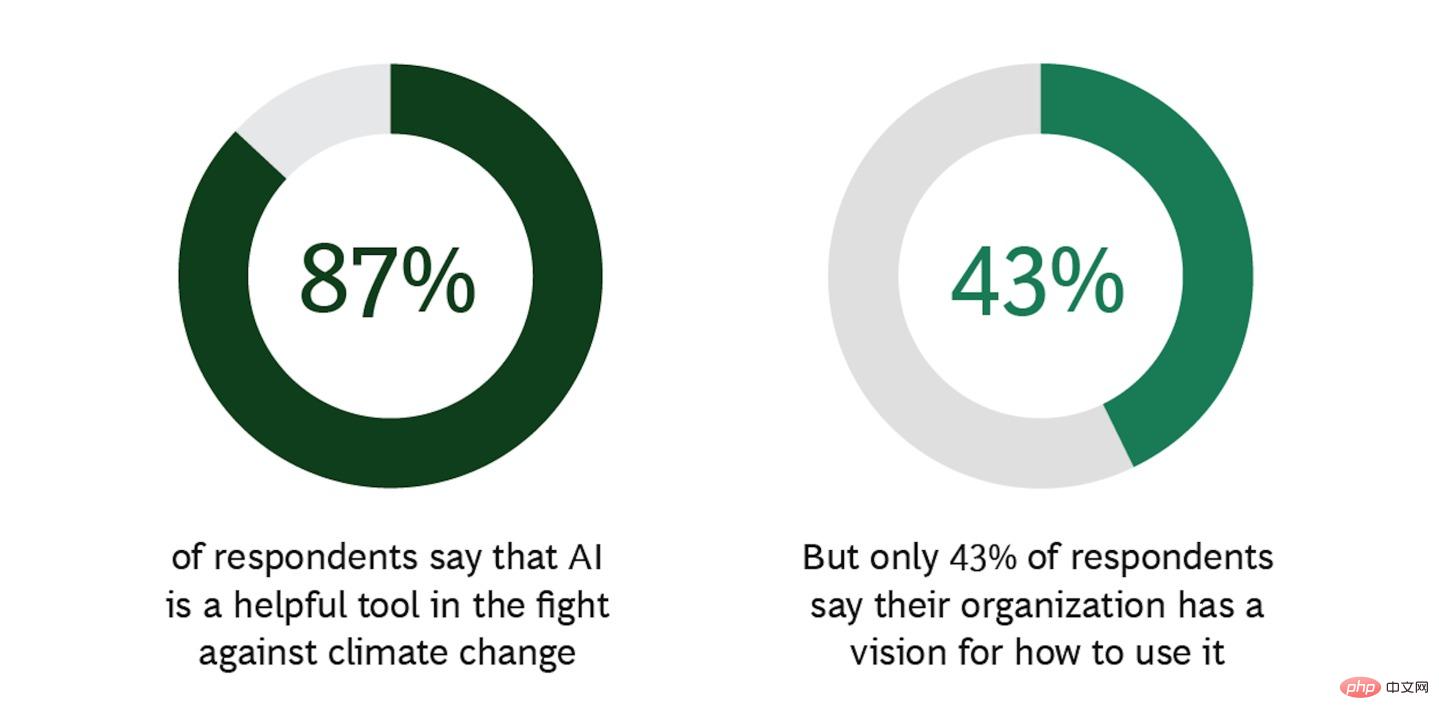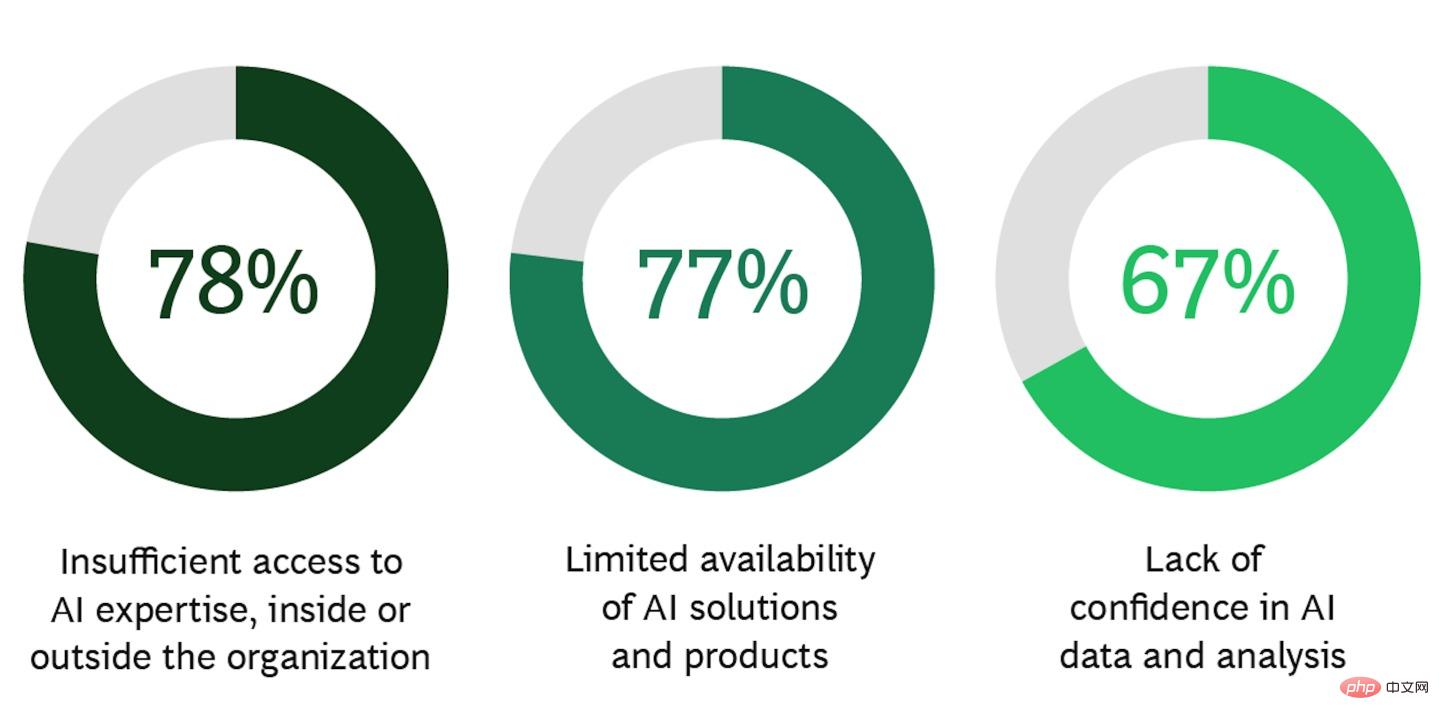 Technology peripherals
Technology peripherals
 AI
AI
 The power of artificial intelligence to help mitigate and manage climate change
The power of artificial intelligence to help mitigate and manage climate change
The power of artificial intelligence to help mitigate and manage climate change
Every day, all of us in our organizations make decisions, potentially hundreds of them—decisions that either increase or decrease sustainability. Which supplier should we choose? Are our products made of green glass or clear glass? Should we hold the meeting in London or New York?

Just as AI improves the decisions organizations make to optimize financial performance, improve processes, meet customer needs and more, it will be critical in helping them achieve their climate goals. In fact, because it can collect, complete and interpret large, complex data sets on emissions and climate impacts, AI is critical to helping manage all climate-related issues.
BCG’s (Boston Consulting Group) recent survey of 1,000 global AI and climate leaders tells us more about AI’s potential, as well as the obstacles standing in the way. The survey found that 87% of respondents believe advanced analytics and artificial intelligence, or "AI" for short, are useful tools in today's fight against climate change, but only 43% said they have any input into their own climate change efforts. visionary efforts to use artificial intelligence in.

About 87% of respondents to the BCG survey found AI to be a useful tool in combating climate change.
They believe that the greatest commercial value of artificial intelligence lies in reducing and measuring emissions. In fact, global leaders can use artificial intelligence in many different ways to achieve their goals:
Mitigation. AI can help measure emissions at macro and micro levels, reduce their impact, and remove existing emissions from the atmosphere. In our work, we find that AI can help reduce greenhouse gas emissions by the equivalent of 5% to 10% of an organization’s carbon footprint, and 2.6 to 5.3 gigatonnes of CO2 equivalent if scaled up globally.
There are some exciting examples of technology already doing this work. Climate TRACE (Tracking Real-time Atmospheric Carbon Emissions), a consortium backed by Al Gore, uses satellite imagery and artificial intelligence to measure emissions. Blue Sky Analytics is a member of Climate TRACE and specializes in estimating emissions from fires. Pachama uses satellite imagery and artificial intelligence to measure and monitor carbon stored in forests over time, identifying high-quality carbon credits.
BCG’s CO2 AI platform helps organizations measure, simulate, track and optimize their emissions at scale. This ready-to-deploy software can be used across all industries, including oil and gas, biopharmaceutical, automotive and consumer products. It not only accurately measures the emissions directly produced by a company’s own activities (Scope 1 and 2), but also quantifies the more difficult-to-measure indirect emissions produced by a company’s entire value chain (Scope 3).
Adaptability and resilience. AI is also well-suited to help predict climate-related disasters, whether by improving long-term forecasts of localized events such as sea level rise, or by upgrading early warning systems for extreme phenomena such as hurricanes or droughts. One example of how artificial intelligence and advanced analytics can help communities adapt to a changing climate is a project in Southeast Asia. By combining satellite data with advanced flood modeling, the team was able to identify critical infrastructure such as hospitals and wetlands most vulnerable to flooding, and understand where strategically placed artificial barriers could have the greatest impact.
AI can also help with vulnerability and exposure management, monitoring current crises, strengthening infrastructure (e.g. through smart irrigation), protecting populations by predicting large-scale migration patterns, and protecting by identifying and counting species Biodiversity.
Research, Finance and Education. AI can also become a tool to support climate research and modeling to understand the scale of change and inform policy decisions. By predicting carbon prices, it can play a key role in climate finance. AI can help educate the public and influence behavior through personalized tools that estimate carbon footprints or make recommendations for climate-friendly purchases. Investing in these AI-driven fundamentals will be key to the success of mitigation and adaptation and resilience efforts.
Overcoming the Barriers to Artificial Intelligence
There are so many powerful opportunities for AI to make a difference in this fight, but what’s stopping organizations from leveraging it more? While AI solutions are already well established and ready for widespread use in some areas, most existing solutions are fragmented, may not be accessible, and lack the resources to scale. Among survey respondents, 78% said barriers were due to insufficient AI expertise, 77% reported limited availability, and 67% reported a lack of confidence in AI-related data and analytics.

About 78% of respondents to the BCG survey said they don’t have access to adequate AI expertise and resources. Source: The Boston Consulting Group
Artificial intelligence is not a panacea, it is one of many tools we should be using to address this global challenge. But it can help us get on a smarter, more data-driven, faster path because we have no time to waste.
The above is the detailed content of The power of artificial intelligence to help mitigate and manage climate change. For more information, please follow other related articles on the PHP Chinese website!

Hot AI Tools

Undresser.AI Undress
AI-powered app for creating realistic nude photos

AI Clothes Remover
Online AI tool for removing clothes from photos.

Undress AI Tool
Undress images for free

Clothoff.io
AI clothes remover

AI Hentai Generator
Generate AI Hentai for free.

Hot Article

Hot Tools

Notepad++7.3.1
Easy-to-use and free code editor

SublimeText3 Chinese version
Chinese version, very easy to use

Zend Studio 13.0.1
Powerful PHP integrated development environment

Dreamweaver CS6
Visual web development tools

SublimeText3 Mac version
God-level code editing software (SublimeText3)

Hot Topics
 1377
1377
 52
52
 Bytedance Cutting launches SVIP super membership: 499 yuan for continuous annual subscription, providing a variety of AI functions
Jun 28, 2024 am 03:51 AM
Bytedance Cutting launches SVIP super membership: 499 yuan for continuous annual subscription, providing a variety of AI functions
Jun 28, 2024 am 03:51 AM
This site reported on June 27 that Jianying is a video editing software developed by FaceMeng Technology, a subsidiary of ByteDance. It relies on the Douyin platform and basically produces short video content for users of the platform. It is compatible with iOS, Android, and Windows. , MacOS and other operating systems. Jianying officially announced the upgrade of its membership system and launched a new SVIP, which includes a variety of AI black technologies, such as intelligent translation, intelligent highlighting, intelligent packaging, digital human synthesis, etc. In terms of price, the monthly fee for clipping SVIP is 79 yuan, the annual fee is 599 yuan (note on this site: equivalent to 49.9 yuan per month), the continuous monthly subscription is 59 yuan per month, and the continuous annual subscription is 499 yuan per year (equivalent to 41.6 yuan per month) . In addition, the cut official also stated that in order to improve the user experience, those who have subscribed to the original VIP
 Context-augmented AI coding assistant using Rag and Sem-Rag
Jun 10, 2024 am 11:08 AM
Context-augmented AI coding assistant using Rag and Sem-Rag
Jun 10, 2024 am 11:08 AM
Improve developer productivity, efficiency, and accuracy by incorporating retrieval-enhanced generation and semantic memory into AI coding assistants. Translated from EnhancingAICodingAssistantswithContextUsingRAGandSEM-RAG, author JanakiramMSV. While basic AI programming assistants are naturally helpful, they often fail to provide the most relevant and correct code suggestions because they rely on a general understanding of the software language and the most common patterns of writing software. The code generated by these coding assistants is suitable for solving the problems they are responsible for solving, but often does not conform to the coding standards, conventions and styles of the individual teams. This often results in suggestions that need to be modified or refined in order for the code to be accepted into the application
 Can fine-tuning really allow LLM to learn new things: introducing new knowledge may make the model produce more hallucinations
Jun 11, 2024 pm 03:57 PM
Can fine-tuning really allow LLM to learn new things: introducing new knowledge may make the model produce more hallucinations
Jun 11, 2024 pm 03:57 PM
Large Language Models (LLMs) are trained on huge text databases, where they acquire large amounts of real-world knowledge. This knowledge is embedded into their parameters and can then be used when needed. The knowledge of these models is "reified" at the end of training. At the end of pre-training, the model actually stops learning. Align or fine-tune the model to learn how to leverage this knowledge and respond more naturally to user questions. But sometimes model knowledge is not enough, and although the model can access external content through RAG, it is considered beneficial to adapt the model to new domains through fine-tuning. This fine-tuning is performed using input from human annotators or other LLM creations, where the model encounters additional real-world knowledge and integrates it
 Seven Cool GenAI & LLM Technical Interview Questions
Jun 07, 2024 am 10:06 AM
Seven Cool GenAI & LLM Technical Interview Questions
Jun 07, 2024 am 10:06 AM
To learn more about AIGC, please visit: 51CTOAI.x Community https://www.51cto.com/aigc/Translator|Jingyan Reviewer|Chonglou is different from the traditional question bank that can be seen everywhere on the Internet. These questions It requires thinking outside the box. Large Language Models (LLMs) are increasingly important in the fields of data science, generative artificial intelligence (GenAI), and artificial intelligence. These complex algorithms enhance human skills and drive efficiency and innovation in many industries, becoming the key for companies to remain competitive. LLM has a wide range of applications. It can be used in fields such as natural language processing, text generation, speech recognition and recommendation systems. By learning from large amounts of data, LLM is able to generate text
 To provide a new scientific and complex question answering benchmark and evaluation system for large models, UNSW, Argonne, University of Chicago and other institutions jointly launched the SciQAG framework
Jul 25, 2024 am 06:42 AM
To provide a new scientific and complex question answering benchmark and evaluation system for large models, UNSW, Argonne, University of Chicago and other institutions jointly launched the SciQAG framework
Jul 25, 2024 am 06:42 AM
Editor |ScienceAI Question Answering (QA) data set plays a vital role in promoting natural language processing (NLP) research. High-quality QA data sets can not only be used to fine-tune models, but also effectively evaluate the capabilities of large language models (LLM), especially the ability to understand and reason about scientific knowledge. Although there are currently many scientific QA data sets covering medicine, chemistry, biology and other fields, these data sets still have some shortcomings. First, the data form is relatively simple, most of which are multiple-choice questions. They are easy to evaluate, but limit the model's answer selection range and cannot fully test the model's ability to answer scientific questions. In contrast, open-ended Q&A
 Five schools of machine learning you don't know about
Jun 05, 2024 pm 08:51 PM
Five schools of machine learning you don't know about
Jun 05, 2024 pm 08:51 PM
Machine learning is an important branch of artificial intelligence that gives computers the ability to learn from data and improve their capabilities without being explicitly programmed. Machine learning has a wide range of applications in various fields, from image recognition and natural language processing to recommendation systems and fraud detection, and it is changing the way we live. There are many different methods and theories in the field of machine learning, among which the five most influential methods are called the "Five Schools of Machine Learning". The five major schools are the symbolic school, the connectionist school, the evolutionary school, the Bayesian school and the analogy school. 1. Symbolism, also known as symbolism, emphasizes the use of symbols for logical reasoning and expression of knowledge. This school of thought believes that learning is a process of reverse deduction, through existing
 SOTA performance, Xiamen multi-modal protein-ligand affinity prediction AI method, combines molecular surface information for the first time
Jul 17, 2024 pm 06:37 PM
SOTA performance, Xiamen multi-modal protein-ligand affinity prediction AI method, combines molecular surface information for the first time
Jul 17, 2024 pm 06:37 PM
Editor | KX In the field of drug research and development, accurately and effectively predicting the binding affinity of proteins and ligands is crucial for drug screening and optimization. However, current studies do not take into account the important role of molecular surface information in protein-ligand interactions. Based on this, researchers from Xiamen University proposed a novel multi-modal feature extraction (MFE) framework, which for the first time combines information on protein surface, 3D structure and sequence, and uses a cross-attention mechanism to compare different modalities. feature alignment. Experimental results demonstrate that this method achieves state-of-the-art performance in predicting protein-ligand binding affinities. Furthermore, ablation studies demonstrate the effectiveness and necessity of protein surface information and multimodal feature alignment within this framework. Related research begins with "S
 Laying out markets such as AI, GlobalFoundries acquires Tagore Technology's gallium nitride technology and related teams
Jul 15, 2024 pm 12:21 PM
Laying out markets such as AI, GlobalFoundries acquires Tagore Technology's gallium nitride technology and related teams
Jul 15, 2024 pm 12:21 PM
According to news from this website on July 5, GlobalFoundries issued a press release on July 1 this year, announcing the acquisition of Tagore Technology’s power gallium nitride (GaN) technology and intellectual property portfolio, hoping to expand its market share in automobiles and the Internet of Things. and artificial intelligence data center application areas to explore higher efficiency and better performance. As technologies such as generative AI continue to develop in the digital world, gallium nitride (GaN) has become a key solution for sustainable and efficient power management, especially in data centers. This website quoted the official announcement that during this acquisition, Tagore Technology’s engineering team will join GLOBALFOUNDRIES to further develop gallium nitride technology. G



